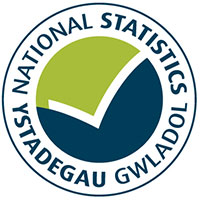The mid-year estimates refer to the population on 30 June of the reference year and are published annually.
This is not the latest release in the series: Mid year estimates of the population
This headline is based on the mid-2022 population estimates for Wales and England published by the Office for National Statistics (ONS).
Main points
- On 30 June 2022 there were estimated to be around 3,132,000 people living in Wales, an increase of 0.8% since mid-2021 (around 26,000 more people).
- The population increase between mid-2021 and mid-2022 has mainly been driven by an increase in net international migration.
- In the year to mid-2022, it is estimated that net international migration to Wales was around 21,900 compared with around 5,400 in the year to mid-2021.
- In the year to mid-2022, there continued to be more deaths than births in Wales.
- There were around 35,700 deaths in Wales in the year to mid-2022, slightly fewer than in the year to mid-2021. The number of births in the year to mid-2022 was around 29,100, which was an increase of 1,100 compared with the year to mid-2021.
Population by age
- People aged 65 years or older were estimated to account for just over a fifth (21.5%, or 674,000 people) of the total population in Wales in mid-2022.
- 60.9% of the population were aged 16 to 64 years old in mid-2022 (around 1,909,000 people).
- Children and young people aged 0 to 15 years old accounted for the remaining 17.5% of the population in mid-2022 (549,000 children and young people).
Population by area
- The population is estimated to have increased in all but one of the local authorities in Wales between mid-2021 and mid-2022, with the largest increases in Cardiff (3.4% increase), Swansea (1.4% increase) and Ceredigion (1.3% increase).
- Conwy is the only local authority whose population is estimated to have decreased between mid-2021 and mid-2022 (a decrease of 0.4%).
Note that methods for measuring international migration are in development and the ONS has updated previously published estimates of international migration for the year ending June 2022. Also, the data used to produce internal migration estimates for 2022 had quality issues which are not fully resolved. If these are more fully resolved, estimates of local population change will be revised. More information can be found in the ONS release: International migration research, progress update: November 2023.
The ONS has also published rebased mid-year estimates for the period 2012 to 2021 to align with Census 2021 data.
The ONS plans to release a full set of UK population estimates for mid-2022 in February 2024. This includes estimates for Northern Ireland produced by the Northern Ireland Statistics and Research Agency (NISRA) and estimates for Scotland produced by National Records of Scotland (NRS).
Note
As agreed with the Office for Statistics Regulation, these statistics will be updated at 12.30pm on the day of release by ONS. StatsWales tables will follow in due course.
Contact
Dan Boon
Email: stats.popcensus@gov.wales
Rydym yn croesawu gohebiaeth yn Gymraeg / We welcome correspondence in Welsh.

